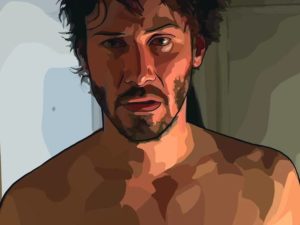We’re thrilled to be screening Richard Linklater’s film adaptation of Philip K. Dick’s novel A Scanner Darkly on May 15. The screening is part of our second season of Science On Screen, is free and open to the public, and will be followed by an engaging talk by Alison Gaye about harm reduction. Rewatching the film was a wildly thought-provoking experience, and this post is intended to meander through a few of my reactions. I’m avoiding plot explanation here, and I highly recommend both watching the film and reading the book if you haven’t already.
Among those who have read the book, Linklater’s film, which was released in 2006, is frequently described as a “faithful” adaptation. In terms of story, this is almost an understatement; it follows the book almost exactly. Most reviewers note the film’s distinctive interpolated rotoscoping technique, which Linklater had used in 2001’s Waking Life. Watching in 2019, Scanner the film manages to look somewhat dated and also totally appropriate to its time and milieu. Take the example of the scramble suit, a brilliant idea and major plot device in both works, allowing its wearer to appear to the outside world as a blur of constantly shifting identities. I thought rotoscoping was pretty much an ideal way to represent the suit, elegantly capturing its essential look as described and giving it a sheen that retains some distance between our world and the world of the film. It would be hard to live up to using more modern techniques. Like digital video formats such as MiniDV, the rotoscope look nails the film to this time period.
It’s interesting to consider that time period compared to the present, in that many ideas whose seeds were sown then have now blossomed into the fabric of our daily lives. Chief among these is the use of surveillance, not as a tool to catch those who have offended, but in a preventative way, for aims that are open-ended or without an obvious goal. As Fred spies on Bob Arctor, watching countless hours of surveillance tape, his psychic wear from drug use is magnified by the mundanity of what he’s seeing: a troupe of addicts doing and talking about nonsensical things that don’t matter. What wears him down, and leads him to self-medicate to a catastrophic degree, is an excess of data, an inability to glean what is useful from oceans and mountains of insignificant information. Of course, this is one of the main side effects of heavy reliance on constant electronic surveillance, and as this has become ubiquitous in our time, programmers have become obsessed with improving ways of sorting through vast quantities of information through tools of advanced data science and machine learning. As Fred’s confusion and frustration mount and mix with his drug-induced paranoia, the sheer volume of information acts as one of the catalysts.
And although governments and companies are highly motivated to optimize large quantities of data, we’re pretty much on our own when it comes to social media and the Internet, which we in “advanced” countries now acknowledge are uniquely addictive and can be crushingly distracting from meaningful life. There’s virtually no check on usage beyond one’s own willpower, and Scanner’s later scenes of Fred reaching peak exasperation while watching tape of his friends is familiar to me as someone who has had the experience of suddenly realizing with howling existential dread that he’s just spent a bunch of time doing nothing online.
As the plot unfurls, it piles on layers of identity, camouflaging intentional obfuscation of powers that be. Powerful entities use characters for their own gain, baiting them against their own well-being while going to great lengths to hide their motivations, and simply shrugging off ethical concerns and grey areas. In one especially prescient parallel, lawsuits accuse the Sackler family of essentially creating the current opioid crisis through misleading and aggressive marketing of OxyContin. With episodes like this constantly the news, questioning of the well-intentionedness of power and authority is beyond de rigeur and actually just sensible.
The film was shot in 2004, three-ish years into post-9/11-hood. Watching now, there’s an easy connection between the paranoia of Dick’s 1970s California speed-freak scene and the early-2000s War On Terror, and onward to the corrosive antipathy toward power on display now. Contemporaneous reviews, maybe not surprisingly, didn’t make much of the political angle. Major reviewers, whether or not they wrote with familiarity about the book, did nothing more than write in passing about “a total surveillance society with a camera on every street corner” or “subtly adding the war on terror to the war on drugs,” or alluding to surveillance as an emerging movie trope. Linklater, as far as I can tell, didn’t conceive of the project in political-allegory terms – it’s more like something was in the air that led him to the story at that point, although the Radiohead soundtrack definitely amplifies the political-subversive element.
Now, as with the book, many aspects of Scanner are ruefully familiar: paranoia, the background of war, drug abuse epidemics, the manipulation of people’s lives for profit, and many more. It’s a brilliant piece of writing, and sees into the future with startling clarity. But the core of the film and book remain the story’s complex, lived sadness. (TB)




